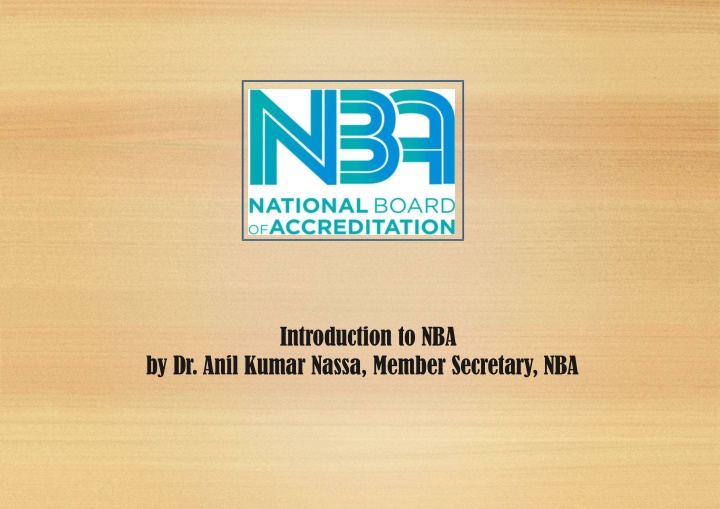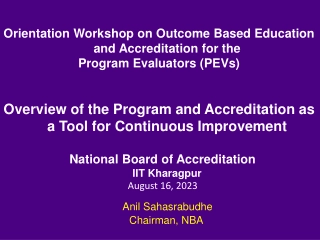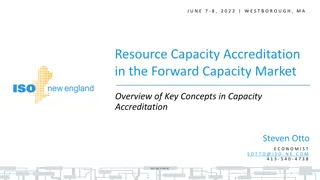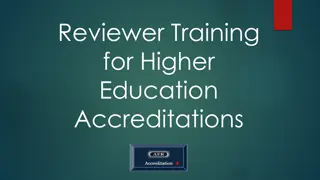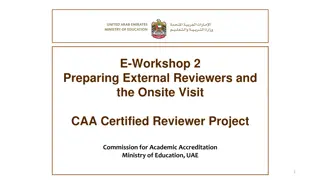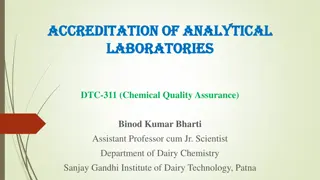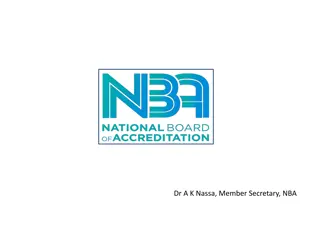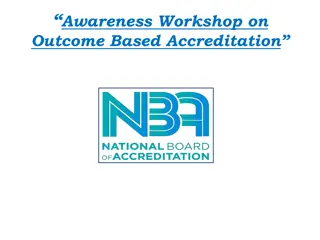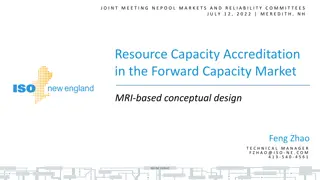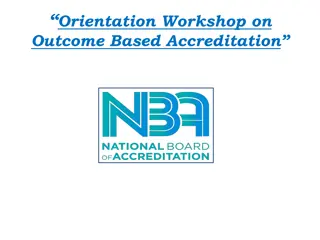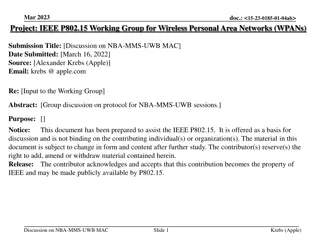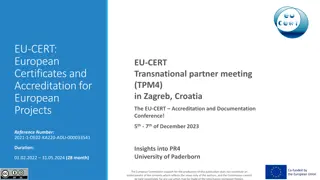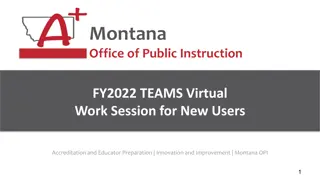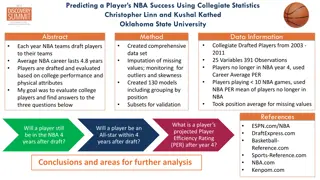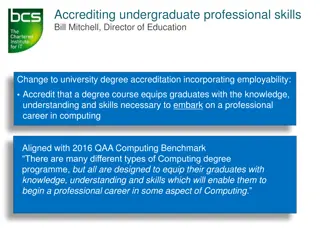Importance of Accreditation in Technical Education by NBA
Accreditation by NBA plays a crucial role in maintaining and enhancing the quality of technical education programs in colleges and universities. It promotes excellence, provides confidence to stakeholders, and ensures continuous quality improvement. Benefits include improved student enrollment, funding opportunities, enhanced employability of graduates, and contribution to social and economic development.
Download Presentation

Please find below an Image/Link to download the presentation.
The content on the website is provided AS IS for your information and personal use only. It may not be sold, licensed, or shared on other websites without obtaining consent from the author.If you encounter any issues during the download, it is possible that the publisher has removed the file from their server.
You are allowed to download the files provided on this website for personal or commercial use, subject to the condition that they are used lawfully. All files are the property of their respective owners.
The content on the website is provided AS IS for your information and personal use only. It may not be sold, licensed, or shared on other websites without obtaining consent from the author.
E N D
Presentation Transcript
Introduction to NBA by Dr. Anil Kumar Nassa, Member Secretary, NBA
ACCREDITATION Accreditation is a process of quality assurance and improvement, whereby a program in an approved Institution is critically appraised to verify that the program continues to meet and/or exceed the Norms and Standards prescribed by regulator from time to time. It is a kind of recognition which indicates that a program fulfills desired standards.
WHY ACCREDITATION The purpose of the accreditation by NBA is to promote and recognize excellence in technical education in colleges and universities - at both the undergraduate and post graduate levels. Institutions, students, employers, and the public at large all benefit from the external verification of quality provided through the NBA accreditation process. They also benefit from the process of continuous quality improvement that is encouraged by the NBA's developmental approach to promote excellence in technical education. Through accreditation, the following main purposes are served: Support and advice to technical institutions in the maintenance and enhancement of their quality of provision;
WHY ACCREDITATION Confidence and assurance on quality to various stakeholders including students; Assurance of the good standing of an Institution to Government Departments, Industry and other interested bodies; Enabling an Institution to state publicly that it has voluntarily accepted independent inspection and has satisfied all the requirements for satisfactory operation and maintenance of quality in education.
BENEFITS AND SIGNIFICANCE OF ACCREDITATION The purpose and impact of accreditation goes far beyond quality assurance of an Institution and its programs. Major impacts of accreditation system are summarized below: Encourages quality improvement initiatives by Institutions; Improves student enrollment both in terms of quality and quantity;
BENEFITS AND SIGNIFICANCE OF ACCREDITATION Helps the Institution in securing necessary funds; Enhances employability of graduates; Facilitates transnational recognition of degrees and mobility of graduates and professionals; Motivates faculty to participate actively in academic and related Institutional / departmental activities; Helps create sound and challenging academic environment in the Institution, and Contributes to social and economic development of the country by producing high quality technical manpower.
WHO GETS ACCREDIT Individuals, courses, and institutions are not accredited. NBA only accredits programs in Engineering, Computer Application, Pharmacy, Management, Hotel Management and Catering Technology.
NATIONAL BOARD OF ACCREDITATION NBA is committed to provide: 1. Credible System of Accreditation 2. Transparent & Accountable System 3
Credible System of Accreditation Strength and credibility of accreditation process largely lies in the integrity, honesty, expertise and professionalism of Evaluators. Evaluators face of NBA. Transparency- Report discussed in the meetings of EAC in presence of all team chair Recommendations of EAC are considered in Sub-committee of AAC Copy of the report is sent to the Institution Change in decision communicated to the institution with reasons 4 360 degree feedback
WASHINGTON ACCORD The membership of Washington Accord is an recognition of the quality of undergraduate education offered by the member country and is an avenue to bring it into the world class category. facilitates the mobility of engineering professionals at international level. international engineering It encourages and graduates and India became Permanent Signatory status in June, 2014 and again in 2020 got the Permanent Signatory status Washington Accord for a further period of six years. In the Washington Accord, India is represented by National Board of Accreditation(NBA). of
WHAT IS NOT THE PURPOSE OF ACCREDITATION Not to find faults with the institution but to assess the status- ante of the performance. Not to denigrate the working style of the institution and its programs but to provide a feed back on their strengths and weaknesses. Not to demarcate the boundaries of quality but to offer a sensitizing process for continuous improvement in quality provisions. Not to select only institutions of national excellence but to provide benchmarks of excellence and identification of good practices.
General Policy on Accreditation The following general policies are the guiding principles for the accreditation of programs: 1. Programs, and Institutions, accreditation. not Educational are considered for 2. Programs from which at least two batches of students have graduated are considered for accreditation.
What is Outcome based Education? 1. What the students need to learn? 2. What the students should demonstrate to the professional world? 3. Accordingly delivery mechanisms(teaching strategies) to build the required skills and competence. designing both curricula and
Program Outcomes (POs)-Present 1. Engineering knowledge: Apply the knowledge of mathematics, science, engineering fundamentals, and an engineering specialization to the solution of complex engineering problems. 2. Problem analysis: Identify, formulate, review research literature, and analyze complex engineering problems reaching substantiated conclusions using first principles of mathematics, natural sciences, and engineering sciences. 3. Design/development of solutions: Design solutions for complex engineering problems and design system components or processes that meet the specified needs with appropriate consideration for the public health, safety, and the cultural, societal, and environmental considerations 4. Conduct investigations of complex problems: Use research-based knowledge and research methods including design of experiments, analysis and interpretation of data, and synthesis of the information to provide valid conclusions. 5. Modern tool usage: Create, select, and apply appropriate techniques, resources, and modern engineering and IT tools including prediction and modeling to complex engineering activities with an understanding of the limitations. 6. The engineer and society: Apply reasoning informed by the contextual knowledge to assess societal, health, safety, legal and cultural issues and the consequent responsibilities relevant to the professional engineering practice.
Program Outcomes (POs)-Present 7. Environment and sustainability: Understand the impact of the professional engineering solutions in societal and environmental contexts, and demonstrate the knowledge of, and need for sustainable development. 8. Ethics: Apply ethical principles and commit to professional ethics and responsibilities and norms of the engineering practice. 9. Individual and team work: Function effectively as an individual, and as a member or leader in diverse teams, and in multidisciplinary settings. 10. Communication: Communicate effectively on complex engineering activities with the engineering community and with society at large, such as, being able to comprehend and write effective reports and design documentation, make effective presentations, and give and receive clear instructions. 11. Project management and finance: Demonstrate knowledge and understanding of the engineering and management principles and apply these to one s own work, as a member and leader in a team, to manage projects and in multidisciplinary environments. 12. Life-long learning: Recognize the need for, and have the preparation and ability to engage in independent and life-long learning in the broadest context of technological change.
NBA Outcome Based Accreditation Two Tier System Introduction of Two-Tier System based on Types of Institutions. The engineering/technology academically university departments and the universities. Tier-I documents applicable programs institutions constituent colleges of to the by by offered autonomous and Tier-II documents: for non-autonomous institutions, i.e., those colleges and technical institutions which are affiliated to a university. For both: Same set of criteria have been prescribed for accreditation.
During the two and a half day visit, team has discussions with: 1. The Head of the institute/Dean/Heads of Department /Program and course coordinators 2. A member of the management (to discuss how the program fits into the overall strategic direction and focus of the institution and management support for continued funding and development of the program) 3. Faculty members 4. Alumni 5. Students 11 6. Employers
Marks Comparison of SAR of UG Engineering Tier-I & Tier II (First Cycle) UGEngineering S.No. Criteria Tier-I Tier-II 1. Vision, Mission and Program Educational Objectives 50 60 2. Program Curriculum and Teaching Learning Processes 100 120 3. Course Outcomes and Program Outcomes 175 120 4. Students Performance 100 150 5. Faculty Information and Contributions 200 200 6. Facilities and Technical Support 80 80 7. Continuous Improvement 75 50 8. First Year Academics 50 50 9. Student Support Systems 50 50 10. Governance, Institutional Support and Financial Resources 120 120 1000 TOTAL 1000
Pre-Qualifiers (TIER-I UG Engineering) S.N. Pre Visit Qualifiers (Average of Assessment years) Current Status Compliance Status Complied/Not Complied Essential qualifiers 1 Vision, Mission & PEOs i. Are the Vision & Mission of the Department stated in the Prospectus / Website? ii. Are the PEOs of the Program listed in the Prospectus / Website? 2 Whether approval of the competent authority (Approval of AICTE/ UGC/ BoG of Universities/ Deemed Universities etc.) under consideration has been obtained for the years including current year for the programs all 3 Whether programs under consideration has been more than or equal to 60% (including lateral entry) average of the CAYm1, CAYm2 and CAYm3. . Whether faculty student ratio in the department under consideration is better than or equal to 1:25 averaged over CAY, CAYm1 and CAYm2 admissions in the undergraduate % Admission 4 SFR
Whether at Professor and one Associate Professor on regular basis with Ph.D. degree is available in the respective Department for CAY and CAYm1. least two Professors or one 6 Whether number of available PhDs in the department is greater than or equal to 20% of the required number of faculty averaged for CAY and CAYm1. 7 Whether two batches have passed out in the programs under consideration 8 Whether HODs possess Ph.D. degrees for the programs under consideration 9
The Student Faculty Ratio considered by NBA: UG Engineering Programs (Tier I & Tier II):- 25:1 for the Accreditation of 3 years and 20:1 for the Accreditation of 6 years. PG Engineering Programs: 25:1 for the Accreditation of 3 years and 20:1 for the Accreditation of 6 years. Diploma Engineering Programs: 30:1 for the Accreditation of 3 years PG Management Programs: 25:1 for the Accreditation of 3 years and 15:1 for the Accreditation of 6 years. UG Pharmacy: 20:1 for the Accreditation of 3 years and 15:1 for the Accreditation of 6 years.
Attributes of Program Evaluators Enthusiastic volunteer Technically competent Well-regarded Effective communication Listening skill Interpersonal skill Team-oriented Professional approach Courteous Time management Organized
Conflict of Interest Definition of possible conflict of interest: have university/institution; or financial or personal interest in the have or have had a close, active association with programme or faculty/school in the Close or active association are, for example: the university/institution. Employment, as staff or consultant; Attendance, as student at the faculty/school; Receipt of honorary degree from the faculty/school; Membership of a board of the university or any committee advising on the programme being accredited.
Major focus during visit Quality assurance processes, including internal reviews Entry standards for admission of students Qualifications, enthusiasm, workload of faculty Facilities Industry participation Title of a programme as shown on graduate s certificate and transcript
Guidelines The evenings of the visiting team are deliberately kept free of activities to enable the team to complete the writing of the report. It is extremely important to note that the visiting team members do not indicate to the institution they would accredit or not and that the report is strictly confidential. whether programme accredit the After the conclusion of the exit meeting, all contacts of the institution should Institution contacts the team members, they should be advised to contact NBA. be through NBA only. If
Assessment by the Experts and the Chairperson should be holistic and fair. Finding must be filled in ink in each and every cell in Program Evaluation Worksheet. If there is any crossing, the same must be counter signed by both the experts. Avoid subjectivity in awarding marks as far as possible.
NBA team members including accommodation and travel to or from the campus where the program is delivered authorized travel agencies. makes travel arrangement for the through the NBA requires every team member to exhibit the highest standard of professionalism, honesty and integrity.
Programs Considered for Accreditation by NBA since 2004-05 Sr. No. Year Accredited Not Accredited Withdrawn Total 1 2 3 4 5 6 7 8 9 2004-05 2005-06 2006-07 2007-08 2008-09 2009-10 2010-11 2011-12 2012-13 2013-14 2014-15 2015-16 2016-17 2017-18 2018-19 2019-20 2020-21 2021-22 2022-23 till July 2023 559 96 464 746 1055 568 73 297 474 550 510 341 739 867 1080 1110 738 1411 2348 513 14539 65 99 90 56 140 88 12 88 126 190 99 52 146 200 198 210 27 50 212 75 2223 11 1 5 19 20 10 0 12 18 0 2 1 2 9 6 2 0 0 7 0 125 635 196 559 821 1215 666 85 397 618 740 611 394 887 1076 1284 1322 765 1461 2567 10 11 12 13 14 15 16 17 18 19 20 588 16887 Total
National Institutional Ranking Framework (NIRF) The National Institutional Ranking Framework (NIRF) for engineering and management categories was unveiled by Ministry of Human Resource Development on 29th September, 2015. Soon after, the NIRF for ranking of the pharmacy and architecture institutions as well as for colleges & universities were released. The final framework identified nearly 22 parameters in five broad generic parameters, namely: i) Teaching, Learning and Resources; ii) Research and Professional Practice; iii) Graduation Outcome; iv) Outreach and Inclusivity; and v) Perception. Several of them are similar to those employed globally such as excellence in teaching, learning and research. However, there are a few which are India- centric, reflecting aspirations of the rising numbers of young people of a vast nation.
S. No. Parameters Marks 1. Teaching, Learning & Resources (TLR) Ranking weight: 0.30 100 A. Student Strength including Doctoral Students(SS): 20 marks B. Faculty-student ratio with emphasis on permanent faculty (FSR): 30 marks C. Combined metric for Faculty with PhD (or equivalent) and Experience (FQE): 20 marks D. Financial Resources and their Utilisation (FRU): 30 Marks 2. Research and Professional Practice (RP) Ranking weight: 0.30 100 A. Combined metric for Publications (PU): 35 marks B. Combined metric for Quality of Publications (QP): 35 marks C. IPR and Patents: Published and Granted (IPR): 15 marks D. Footprint of Projects and Professional Practice (FPPP): 15 marks
3. Graduation Outcomes (GO) Ranking weight: 0.20 A. Metric for University Examinations(GUE): 60 marks B. Metric for Number of Ph.D. Students Graduated (GPHD): 40 marks Outreach and Inclusivity (OI) Ranking weight: 0.10 A. Percentage of Students from Other States/Countries (Region Diversity RD): 30 Marks B. Percentage of Women (Women Diversity WD): 30 Marks C. Economically and Socially Challenged Students (ESCS): 20 marks D. Facilities for Physically Challenged Students (PCS): 20 marks 100 4. 100 5. Perception (PR) Ranking weight: 0.10 A. Peer Perception: Academic Peers and Employers (PR): 100 Marks 100
India Rankings 2016 2023 1. In the year 2016, rankings were announced for the first time for Universities and for the specific disciplines of Engineering, Management and Pharmacy. 2. In India Rankings 2017, Common Overall Ranking and Ranking of General Degree Colleges was introduced. 3. In India Rankings 2018, three new categories namely, law, medicine and architecture were introduced bringing the tally to total nine rankings. 4. In India Rankings 2019, the NIRF continued with all these nine rankings. 5. In India Rankings 2020, new category Dental were introduced bringing tally to ten rankings . In India Rankings 2021, new category Research Institutions were introduced bringing tally to eleven rankings . 6. 7. In India Rankings 2022, the NIRF was released for 11 categories. 8. In India Rankings 2023, two more category Agriculture and Allied Sectors and Innovation were introduced bringing tally to thirteen rankings.
